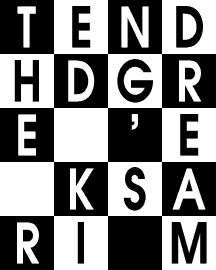 |
    by Wanderer Werewolf ©2008 Wanderer Werewolf |
||
|
|
|||
 |
    by Wanderer Werewolf ©2008 Wanderer Werewolf |
||
|
|
|||
Welcome back to The Red King’s Dream. As a special treat for everyone’s ‘deer’ friend, Jon “JonBuck” Sleeper, this month’s column will look at libraries; not only a subject near and dear (I’m trying not to overuse the pun) to his cervine heart, but central to many settings.
Of course, the modern reader knows his local library. Even if he’s never seen the inside of it, he knows what to expect: Row upon row of bookcases, a friendly librarian, and either a reference computer or a card catalog (or even both) depending on how recently the library has been updated. Quiet rooms, desks with at least semi-comfortable chairs, and hundreds to millions of books ready to be borrowed.
Oh, how times have changed!
In the Middle Ages, from which we draw most of our ‘fantasy’ elements, a free lending library was almost unheard of. Papyrus shipments from Egypt had stopped with the fall of Rome, and parchment was much more expensive—it’s tanned lambskin, after all. Few libraries were even public, and those generally chained the books (libri catenati, ‘chained books’) to desks, tables and walls (just in case you ever wondered where Ms. Rowling got the idea for those chained books at Hogwarts). Private libraries had fewer metal chains, but more legal ones; permissions, memberships and subscriptions were the order of the day, and most people never saw the books.
Go back further, to Rome, and the picture improves a bit: Roman libraries were immensely popular, and always a good investment for the Emperor who needed to buy a little good will. The Ulpian Library, built for Emperor Trajan, was a prime example: Roughly 20,000 scrolls in two sumptuously-appointed rooms (one for Greek scrolls, one for Latin) to either side of Trajan’s Column. Even Roman baths were known to have had libraries attached… but few indeed were those who could borrow a book therefrom. Lending was strictly limited, and by no means a general policy. Most of the time, a scholar who wished to consult a book would be allowed to view it in the library itself or an adjoining room, make a copy of relevant portions, and… that would be that. (This model often appears in fantasy games and literature as the “wizard’s guild” sort of library. The Palladium Fantasy RPG models it most closely, although the Guild Library in the Eberron campaign setting from Wizards of the Coast comes quite near the mark.)
At the same time, the libraries of Islam were even more impressive. Full lending services, scientific discussion groups, lavish gardens… but still not quite free to the public. Still, until the centuries-later decline of Islam’s educational system, their libraries would be unbeatable.
Further still, and… archives. Nothing but archives. Fine if you want to find out who bought what, when, and where, but not a great deal of help otherwise. (It’s believed the occasional bits of folklore and religion found in the old Sumerian clay tablets may have been practice for new scribes; rather like finding an Accounting 101 textbook in the company’s financial records.)
No, the free modern library only dates to 1803, when the Scoville Memorial Library of Salisbury, Connecticut was established. For its time, it was revolutionary: No membership fees, no restrictions, and a free lending policy. (You did have to pay if your candle dripped on the pages, however.) Previous ‘public’ libraries had been run on a subscription model, charging a membership fee to use the books (this was the model used by Benjamin Frankin and his Leather Apron Club). In 1810, the Scoville Library even became publicly supported—a first for its day. With refreshments, a full auditorium, and a musical clock (installed in the 1890s; it plays a selection from Parsifal on the quarter, half, three-quarter and full hour), it was (and still is!) a truly magnificent example of Nineteenth-Century ‘learning in luxury’.
In 1876, however, three important things shook the world of the library:
The Schools Act provided for free public schooling. In years to come, this would vastly increase the demand for books, and thus for libraries.
The American Library Association (and its newsletter, the American Library Journal) were established, marking the first central authority (such as it is) for librarians and their offices.
And what was, in a way, the most impressive innovation: Melvil Dewey created his decimal classification system. For the first time, books had a simple and orderly system of classification that could be stamped on the binding, allowing for faster and easier shelving of materials. While not perfect (it was designed in the Nineteenth Century, after all; everything that doesn’t fit into one of the defined categories winds up assigned to the ‘000’s in ‘General Knowledge’), it’s still the best system available, especially with the modifications that have periodically been made since Dewey’s day. (The last update was only four years ago as of this writing.)
And now, the library keeps growing and changing. DVDs, CDs, videos, computer games… almost everything is available from your local library. Looking ahead, who knows what’s next? VR movies? E-book reader lending services? Like the books within them, the possibilities for libraries stretch forward into the blank pages of tomorrow… and we’re all waiting to see what The Author writes next.
Now: How can libraries impact your game or story? Well, aside from research materials (and even 1st Edition D&D, in some cases), consider:
Next time, we’ll take a look at books through the ages. Trust me, if you think libraries have changed a lot, just wait until you see how the Fall of Rome created the modern book!
Until next time, this is the bibliomaniacal Wanderer, giving a shout out to, yes, that deer friend, Jon (JonBuck) Sleeper. Take care of yourself!